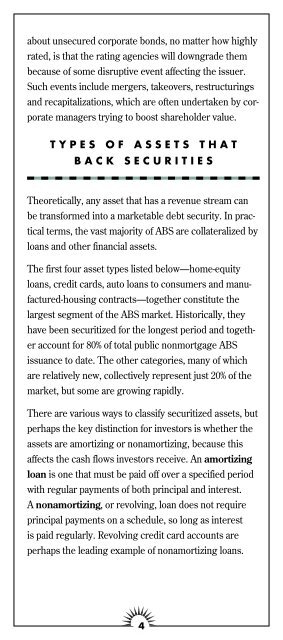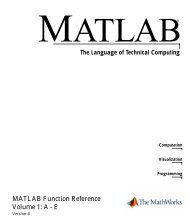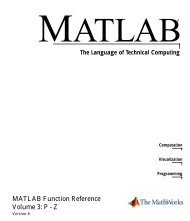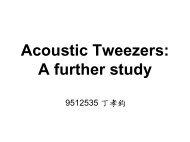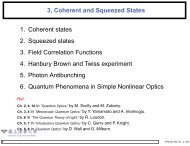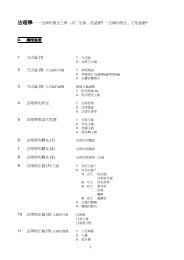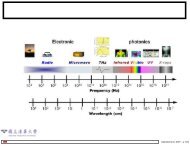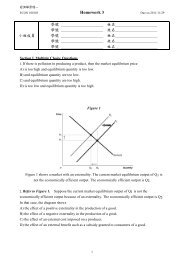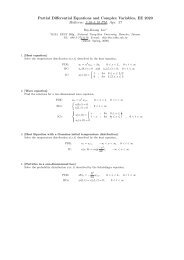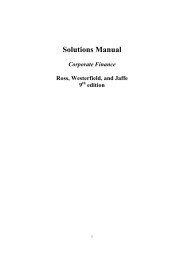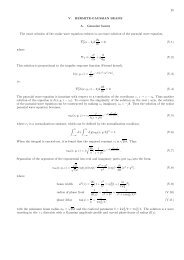assetbacked Pages
assetbacked Pages
assetbacked Pages
Create successful ePaper yourself
Turn your PDF publications into a flip-book with our unique Google optimized e-Paper software.
about unsecured corporate bonds, no matter how highly<br />
rated, is that the rating agencies will downgrade them<br />
because of some disruptive event affecting the issuer.<br />
Such events include mergers, takeovers, restructurings<br />
and recapitalizations, which are often undertaken by corporate<br />
managers trying to boost shareholder value.<br />
TYPES OF ASSETS THAT<br />
BACK SECURITIES<br />
Theoretically, any asset that has a revenue stream can<br />
be transformed into a marketable debt security. In practical<br />
terms, the vast majority of ABS are collateralized by<br />
loans and other financial assets.<br />
The first four asset types listed below—home-equity<br />
loans, credit cards, auto loans to consumers and manufactured-housing<br />
contracts—together constitute the<br />
largest segment of the ABS market. Historically, they<br />
have been securitized for the longest period and together<br />
account for 80% of total public nonmortgage ABS<br />
issuance to date. The other categories, many of which<br />
are relatively new, collectively represent just 20% of the<br />
market, but some are growing rapidly.<br />
There are various ways to classify securitized assets, but<br />
perhaps the key distinction for investors is whether the<br />
assets are amortizing or nonamortizing, because this<br />
affects the cash flows investors receive. An amortizing<br />
loan is one that must be paid off over a specified period<br />
with regular payments of both principal and interest.<br />
A nonamortizing, or revolving, loan does not require<br />
principal payments on a schedule, so long as interest<br />
is paid regularly. Revolving credit card accounts are<br />
perhaps the leading example of nonamortizing loans.<br />
4<br />
Home-Equity Loans<br />
These loans now constitute the largest sector of the ABS<br />
market. Forty-two percent of the ABS issued in the first<br />
half of 1998 were backed by closed-end home-equity loans<br />
(HELs) and open-end loans, which are also called homeequity<br />
lines of credit (HELOCs). Both types of loans<br />
enable homeowners to borrow against the nonmortgaged<br />
value of their homes, and often use these loans to consolidate<br />
all their debt into one monthly payment. The interest<br />
on HELs is generally tax deductible.<br />
A closed-end loan may be a second mortgage on a property<br />
or, increasingly, a first mortgage. HELs have a fixed<br />
term, typically from 10 to 30 years. Generally, borrowers<br />
who take out HELs as their first mortgage are known as B<br />
or C borrowers; they are people with impaired credit. As<br />
mortgages, HELs are amortizing assets.<br />
HELOCs, in contrast, provide a revolving credit line<br />
against which homeowners may borrow as they wish for a<br />
number of years. They are similar to credit card receivables<br />
and are generally considered nonamortizing assets<br />
(although some are partially amortizing because they<br />
require small, regular principal payments).<br />
Credit Cards<br />
Securities collateralized by credit card receivables are one<br />
of the oldest segments of the ABS market, representing<br />
18.8% of ABS issuance in the first half of 1998. Until the<br />
last year or two, when HELs experienced such explosive<br />
growth, credit cards were the predominant sector of the<br />
ABS market. Holders of credit cards may borrow funds,<br />
generally on an unsecured basis up to an assigned limit,<br />
and pay the principal and interest as they wish, as long as<br />
they make a small required minimum payment on a regular<br />
basis—generally once a month. Consumers may also<br />
borrow more money while paying off the old debt, if they<br />
do not exceed the credit limit. Because cardholders do not<br />
5


